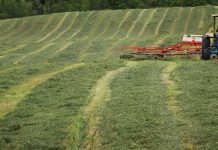A positive management attitude can have a tremendous impact on the quality of milk that leaves your farm.
You probably have heard about companies working to achieve continuous improvement in the products they produce or services they provide. In the dairy industry, bulk tank somatic cell count is the standard benchmark and is a measure of continuous improvement.
Research has shown that attitude is a key component in the continuous improvement process.
Let’s take a look at the effect attitude can have on the quality of milk produced on your farm.
Management attitude. An Ontario study compared bulk milk tanks on dairies with the exact same facilities, feed, genetic base and environment and found these farms often had differing productivity levels.
The only difference between the herds was the herd manager; thus, implicating management as the main cause for differences in productivity.
Tidiness does not always mean a farm has a low bulk tank somatic cell count. There are some untidy farms that produce high quality milk with a low bulk tank somatic cell count and vice versa.
However, bulk tank somatic cell count has been shown to be a dependable predictor not only of milk quality, but also of general herd management.
The bottom line reflecting differences in management attitude are captured in the following questions:
Are you just milking cows or are you producing quality milk? Are you just dipping teats or are you using a dip cup to completely immerse teats?
There is an attitude difference and the resulting behavior is reflected in somatic cell count levels.
In one study, researchers categorized farmers by their management style. The two categories included “clean and accurate” and “quick and dirty.”
The most evident difference between the two categories was that the “clean and accurate” farmers:
* rarely forgot to take milk samples for culture of clinical cases;
* enjoyed milking more;
* were more likely to use records daily;
* were more likely to wash their hands, boots, etc.;
* were less likely to start milking later than planned; and
* kept their farmstead, milking parlor and bulk tank room cleaner.
Consistency factor. Being consistent in your processes and reducing variation in bulk tank somatic cell count levels requires accurate and consistent application of milk quality management practices.
The following example demonstrates the impact consistency can have on bulk tank somatic cell count levels.
A dairy herd in Wisconsin had kept its bulk tank somatic cell count level under 200,000 for 20 years.
During the period from January through mid-February of 1999, the bulk tank somatic cell count was averaging 140,000 and was in control.
However, the herd manager felt the level should be 100,000 or less.
On March 21, 1999 the herd manager and his staff met with extension specialists to develop a plan of action.
This plan included the following:
* more attention would be placed on pre-milking and teat end sanitation, and
* cows with extremely high somatic cell count quarters would be identified with a leg band so that high somatic cell count quarters could be milked into a bucket.
Did the plan work? Yes, and with almost instant results.
By March 26 the herd manager saw results and knew the plan was working. Since implementing the plan the bulk tank somatic cell count levels have stayed below 140,000.
Implementing this plan proved to be of economic importance to the farm and the results helped employees understand the impact they can have on milk quality.
Enhance quality. Developing a milk quality mind set can pay big dividends on your dairy, especially as margins get tighter.
Implementing continuous improvement plans and emphasizing details should be a part of this plan. In addition, consumer confidence of milk and dairy products is still rather high, and striving for continuous improvement will help maintain this favorable rating.
Source: Dr. Jeffrey Reneau, DVM, University of Minnesota. Proceedings from the Four-State Professional Dairy Management Seminar, MWPS-4SD13, June 19-20, 2002.
(The author is an agricultural extension agent in Tuscarawas County and a member of the OSU Extension DairyExcel team. Questions or comments can be sent in care of Farm and Dairy, P.O. Box 38, Salem, OH 44460.)












